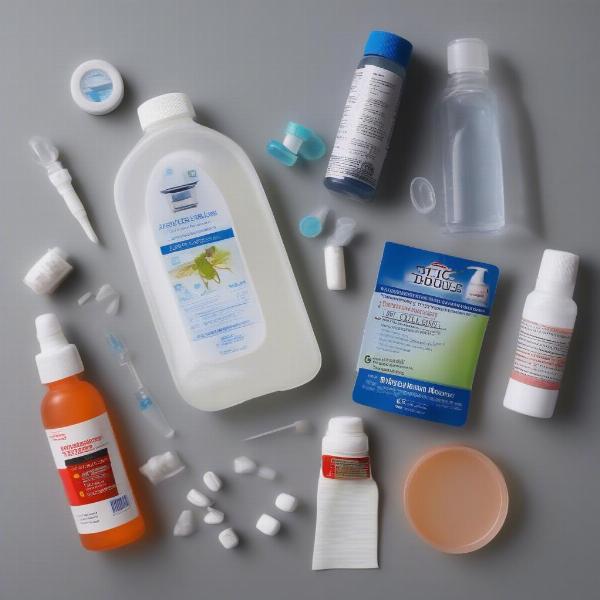Protecting your furry friend from ticks and fleas is crucial for their health and well-being. These parasites can cause a range of problems, from simple itching and irritation to more serious diseases like Lyme disease, ehrlichiosis, and tapeworms. Choosing the right tick and flea treatment for your dog can feel overwhelming with so many options available. This guide will provide you with all the information you need to make an informed decision and keep your canine companion parasite-free.
Understanding the Importance of Tick and Flea Control
Ticks and fleas are more than just a nuisance. They can transmit diseases that can significantly impact your dog’s health, and in some cases, even your own. Regular tick and flea treatment is a preventative measure that safeguards your dog’s health and comfort. Choosing the right treatment depends on various factors, including your dog’s age, breed, lifestyle, and the prevalence of ticks and fleas in your area.
Types of Tick and Flea Treatments for Dogs
There are several types of tick and flea treatments available, each with its own advantages and disadvantages:
- Topical Treatments: These are applied directly to your dog’s skin, usually on the back of the neck. They are available as spot-on treatments, sprays, and wipes. Topical treatments typically kill fleas and ticks on contact and can provide protection for several weeks.
- Oral Medications: These are pills or chewable tablets that are given to your dog orally. They work by disrupting the flea and tick life cycle, preventing them from reproducing. Oral medications usually provide protection for a month or longer.
- Flea and Tick Collars: These collars release insecticide over time, killing fleas and ticks on contact. They offer continuous protection for several months.
- Natural Treatments: For those seeking more natural options, there are various natural remedies available, including essential oil-based sprays and shampoos. However, it’s important to consult with your vet before using these treatments, as some essential oils can be toxic to dogs.
 Various tick and flea treatments displayed on a table
Various tick and flea treatments displayed on a table
Choosing the Right Tick and Flea Treatment for Your Dog
The best tick and flea treatment for your dog depends on several factors:
- Age and Breed: Some treatments are not suitable for puppies or certain breeds. Always check the product label to ensure it is appropriate for your dog.
- Lifestyle: If your dog spends a lot of time outdoors or swimming, you’ll need a treatment that is waterproof and long-lasting.
- Severity of Infestation: In cases of severe infestation, you may need to use a combination of treatments or consult a veterinarian for a stronger solution.
How to Apply Tick and Flea Treatments
Always follow the manufacturer’s instructions carefully when applying any tick and flea treatment. For topical treatments, part the fur on the back of your dog’s neck and apply the solution directly to the skin. For oral medications, hide the pill in a treat or give it directly to your dog. Ensure your dog doesn’t lick off the topical treatment or chew on the flea collar.
Prevention is Key
While treatments are essential, preventing tick and flea infestations is equally important. Regularly check your dog for ticks and fleas, especially after they’ve been outdoors. Keep your yard clean and free of debris, and wash your dog’s bedding frequently.
Conclusion
Protecting your dog from ticks and fleas is a vital part of responsible pet ownership. By understanding the various treatment options and taking preventative measures, you can ensure your furry friend stays healthy and happy. Choose the right tick and flea treatment based on your dog’s specific needs and always consult your vet if you have any questions or concerns.
FAQ
- How often should I treat my dog for ticks and fleas? Most treatments provide protection for one to three months. Follow the manufacturer’s recommendations.
- Are tick and flea treatments safe for puppies? Not all treatments are safe for puppies. Consult your veterinarian for recommendations for your puppy’s age and breed.
- What should I do if my dog has a reaction to a tick and flea treatment? Contact your veterinarian immediately if your dog experiences any adverse reactions.
- Can I use cat flea and tick treatment on my dog? No. Cat flea and tick treatments contain ingredients that are toxic to dogs.
- What are the signs of a tick or flea infestation? Excessive scratching, biting, hair loss, and redness are common signs.
- Are natural tick and flea treatments effective? Some natural treatments can be effective, but it’s best to consult with your vet before using them.
- Can I prevent ticks and fleas completely? While complete prevention is difficult, regular treatments and preventative measures can significantly reduce the risk of infestation.
ILM Dog is your trusted partner in providing comprehensive canine care. We offer expert advice on everything from breed selection and health care to training, nutrition, grooming, and accessories. We are dedicated to helping you give your furry friend the best possible life. Contact us for personalized guidance on tick and flea treatment options and more. Email: [email protected] Phone: +44 20-3965-8624. ILM Dog is here to support your dog’s well-being every step of the way.